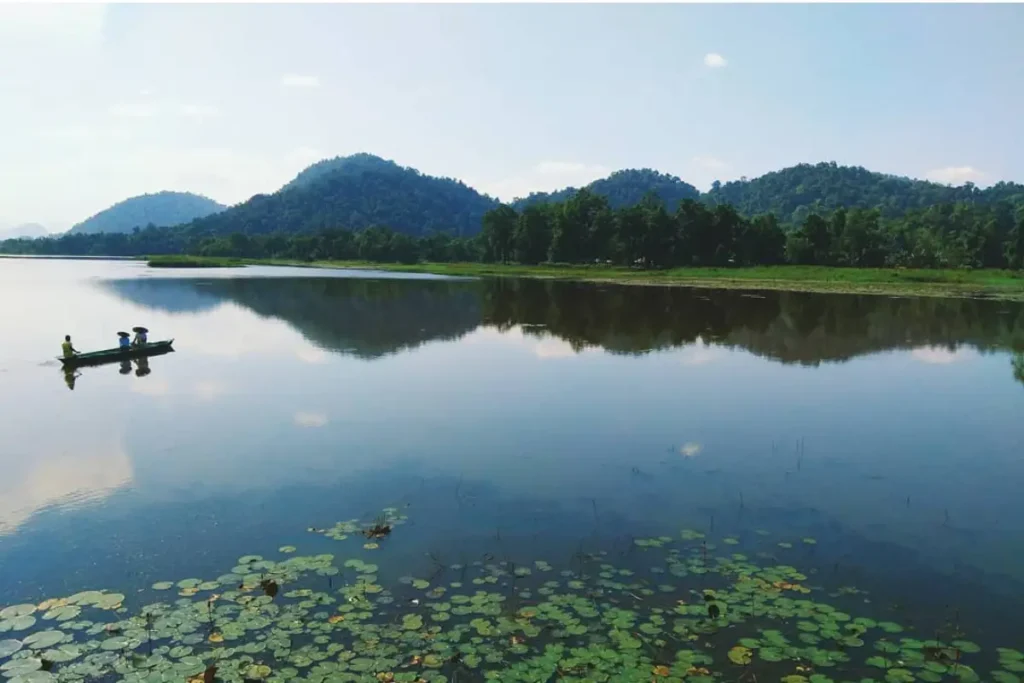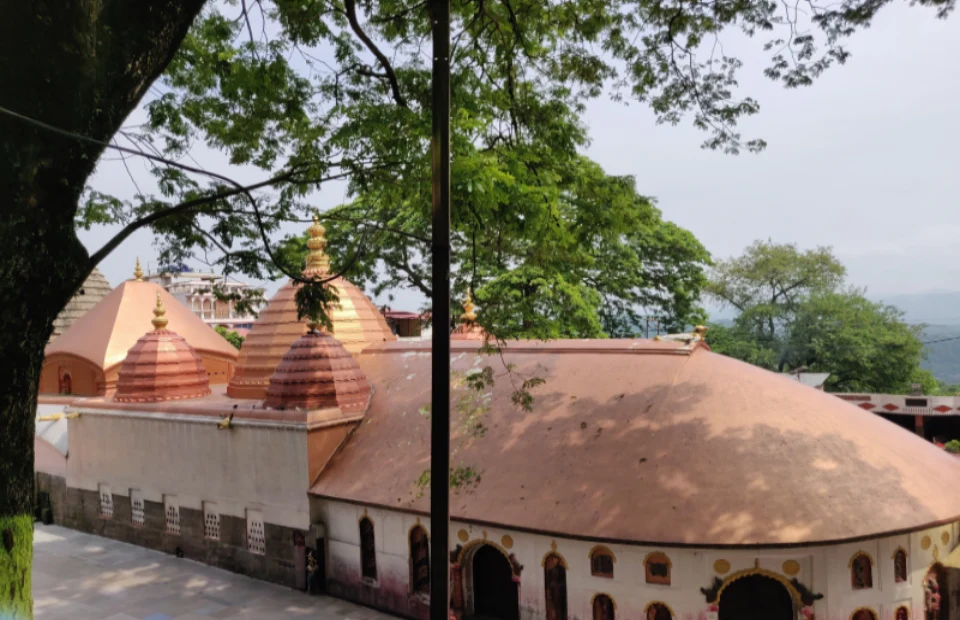Explore Chandubi Beel, a beautiful natural lake near Guwahati. Enjoy its scenic beauty, diverse fauna, and vibrant local culture, and the Chandubi festival.
Diversity Assam
Updated on :
Share this post
Chandubi Beel is a beautiful creation of nature. Escape from your busy life to the peaceful beauty of Chandubi. Situated on the Assam-Meghalaya border, Chandubi Beel is a remarkable creation of nature, rich in biodiversity. Surrounded by lush green hills and dense forests, Chandubi offers a tranquil and peaceful environment. Its natural beauty is complemented by diverse flora and fauna that thrive in a vibrant ecosystem.
If you want to relax and connect with nature, Chandubi Beel is perfect place for you. Enjoy the captivating landscapes, feel the tranquil ambiance, and let this peaceful spot refresh your mind and body.

Location
Chandubi Beel is nestled in the Rabha Hasong Autonomous Council area of Kamrup district, Assam. Located about 65 km from Guwahati, this picturesque lake rests at the foothills of the Garo Hills, near the Assam-Meghalaya border.
Formation and Mythology of Chandubi beel
There are many legends and disagreements about the history of Chandubi Beel. The tall sal and teak trees by the lake narrate its story to every visitor. However, everyone agrees that the beel was formed after the devastating earthquake of June 12, 1897. This massive quake, with a magnitude of 8.7 on the Richter scale, caused the land in this area to sink. Five nearby hills collapsed and slowly submerged underwater, leading to the formation of Chandubi Beel. Local people view the beel as a unique gift of nature and consider it a priceless natural treasure of Assam.
There is a legend about the formation of Chandubi Beel that says it existed as a wetland thousands of years ago. However, its current form likely did not exist at that time. Many believe a wetland existed in this area, though its name remains uncertain. It might have been called Chandubi or something entirely different.
There are different opinions about the origin of Chandubi’s name. It is said that the Boro, Kochari, Rabha, Khasi, and other communities once lived near the present-day Chandubi area. It is believed that the Khasi language influenced the region in various ways. The Khasi people used to offer prayers to various deities in the past. According to legend, there was a water body (dubi) in the area where five deities (Chan Ublei) were worshiped. In Khasi, ‘Chan’ means five, and ‘Ublei’ means deity. Over time, the name ‘Chan Ublei’ is believed to have transformed into ‘Chandubi,’ as the local lore suggests.
Key Attractions of Chandubi Beel

Natural Beauty: Chandubi Beel is a picturesque land of natural elegance. Surrounded by evergreen forests, it captivates visitors with its beauty. It is one of the most popular tourist destinations near Guwahati. The natural serenity of Chandubi Beel can mesmerize any traveler who visits it. Its calm, clear water, lush green forests, and nearby hills make the place unique. The sunrise and sunset here offer enchanting views that enhance the lake’s allure. The area is lined with sal, teak, and other forest trees, creating a haven for nature lovers like you. Exploring Chandubi Beel’s beauty will fill you with a sense of refreshment and inspiration.
Another unique feature of Chandubi Beel is the opportunity to spot elephants in their natural habitat. At any moment, you might witness a herd of elephants, sometimes numbering 50 to 100, wandering through the surrounding forests. This rare sight adds to the charm of the place and offers a memorable experience for wildlife enthusiasts.
Flora & Fauna: Chandubi Beel is a haven of biodiversity, providing a unique habitat for nature’s wonders. It is home to various animals, birds, fish, turtles, aquatic plants, and migratory species. The surrounding sal, teak, bamboo, and other forest trees enhance the area’s natural charm. You can observe numerous aquatic plants, climbers, and thriving local bird species. Birds such as herons, ducks, and migratory species frequently capture visitors’ attention. Beyond birds, the lake also supports fish, turtles, and a diverse array of aquatic life. This rich biodiversity gives Chandubi Beel the essence of a natural sanctuary. The harmony of nature and wildlife elevates the beauty and allure of this mesmerizing destination.
Chandubi Beel Festival: The Chandubi Beel Festival is a major attraction in the region. It is celebrated every year in the first week of January. This festival showcases local culture and traditions through folk music, dance, and handicrafts. You can enjoy a variety of traditional delicacies during the event. One of the highlights is the folk dance and music, reflecting the region’s vibrant heritage.

The festival provides a platform for local artists and introduces visitors to the local lifestyle and traditions. By attending the Chandubi Beel Festival, you not only explore the cultural richness but also enjoy the unique natural beauty of the area. It promises you an enjoyable and enriching experience.
Activities to Do
You can enjoy various activities at Chandubi Beel, making your visit more delightful.

Take a boat ride on the serene waters of the beel. Local youths skillfully guide the traditional dinghy boats, allowing you to explore from one end to another.
Fishing enthusiasts can try fishing in designated areas, using rods for an exciting experience.
The lush forests around Chandubi Beel offer opportunities for wildlife and bird watching. You may spot elephants, herons, and various local birds, adding to the place’s charm.
Chandubi Beel provides well-equipped picnic spots where you can relax and enjoy quality time with family and friends amidst nature.
For adventure seekers, Chandubi Beel offers the unique experience of jungle camping. Spend the night under the starry sky, surrounded by the tranquility of the forest. Camping here lets you immerse yourself in nature while enjoying bonfires and the soothing sounds of wildlife. This activity adds an adventurous touch to your visit, making it truly unforgettable.
Best Time to Visit
The ideal time to visit Chandubi Beel is between November and February, during the winter months. The weather remains pleasant and perfect for outdoor activities like boating, camping, and birdwatching. This period also coincides with the migratory bird season, offering you a chance to witness exotic bird species.
Additionally, the Chandubi Beel Festival, held in January, adds to the charm of visiting during this time. The festival showcases local culture, traditional dances, and delicious cuisine, making your trip even more memorable. Winter ensures you experience the lake’s natural beauty at its best.
How to Reach
Chandubi Beel is well-connected and easily accessible from Guwahati.
By Road: Chandubi is located about 65 km from Guwahati. You can hire a taxi or drive via NH17 and Chandubi Road. Local buses and private vehicles also operate from Guwahati to nearby areas.
By Train: The nearest railway station is in Guwahati Railway Station. From there, Chandubi Beel is about 57 km away. You can hire a cab or take a bus to reach Chandubi Beel.
By Air: The closest airport to Chandubi Beel is Lokpriya Gopinath Bordoloi International Airport in Guwahati. From the airport, you can take a bus or cab via NH 37 toward Goalpara. Travel about 10 km west from the airport to reach the small town of Mirza. From Mirza, head south along a direct road for approximately 35 km to reach Chandubi Beel.
Bottomline
Chandubi Beel is a unique gift of nature, offering stunning beauty and a peaceful environment to everyone. Its calm atmosphere and picturesque scenery will mesmerize you, making it an ideal escape from daily life. Explore Chandubi Beel to enjoy nature, engage in tourism, and connect with local culture at its best. The vibrant biodiversity, traditional festivals, and fun activities make this place more attractive for visitors.
FAQs
Where is Chandubi Beel located?
Chandubi Beel is located in the Rabha Hasong Autonomous Council area of Kamrup district, Assam. It is situated about 65 kilometers from Guwahati city.
Which earthquake formed Chandubi Lake?
Chandubi Lake was formed as a result of the earthquake that struck Assam in 1897. This earthquake, which is one of the most significant in Indian history, caused the land to subside and created the lake, along with other geographical changes in the region.
What is Chandubi Lake famous for?
Chandubi Lake is famous for its natural beauty, rich biodiversity, and cultural significance. It’s a great spot for boating and birdwatching, attracting nature lovers and tourists. The lake is also close to other attractions, making it a popular destination in Assam.
Which tribe celebrates the Chandubi festival?
The Boro tribe celebrates the Chandubi Festival. This festival highlights their culture, traditions, and lifestyle, featuring various culture perfomances, traditional foods, and rituals that showcase their rich heritage.



